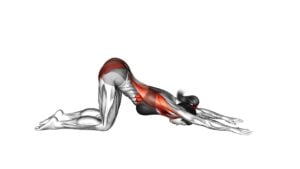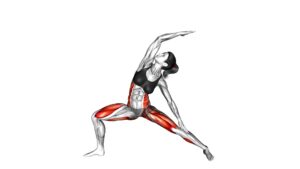Thread the Needle Pose (female) – Video Exercise Guide & Tips

Are you looking for a new yoga pose to add to your routine?
Watch This Exercise Video
Look no further than the Thread the Needle Pose.
This pose not only helps to stretch and strengthen your upper back and shoulders but also promotes relaxation and stress relief.
In this video exercise guide, we'll show you how to properly perform the pose and provide helpful tips to enhance your practice.
Get ready to thread the needle and experience the benefits for yourself.
Key Takeaways
- Thread the Needle Pose improves flexibility.
- It relieves tension in the upper back and shoulders.
- The pose enhances overall well-being.
- It increases range of motion.
Benefits of Thread the Needle Pose
To reap the benefits of Thread the Needle Pose, you can improve your flexibility and relieve tension in your upper back and shoulders. This pose, also known as Parsva Balasana in Sanskrit, offers numerous health benefits that can enhance your overall well-being.
One of the main health benefits of Thread the Needle Pose is the improvement in flexibility. As you twist your torso and reach your arm through the space between your knees, you stretch and lengthen the muscles in your back, shoulders, and chest. This can help to increase your range of motion and improve your overall flexibility.
Additionally, Thread the Needle Pose is excellent for relieving tension in the upper back and shoulders. Many people carry stress and tightness in these areas due to poor posture, desk jobs, or repetitive movements. By gently twisting and stretching these muscles, you can release built-up tension and experience a sense of relief.
There are also variations and props that can be used to modify Thread the Needle Pose. For example, if you have limited flexibility or wrist issues, you can use a bolster or block to support your upper body. This allows you to still experience the benefits of the pose while making it more accessible and comfortable for your specific needs.
How to Perform Thread the Needle Pose
To perform Thread the Needle Pose, start by lying on your back with your knees bent and feet flat on the floor. Follow these steps to correctly execute the pose:
- Extend your right leg and cross your left ankle over your right thigh.
- Bring your right knee towards your chest and interlace your fingers behind your right thigh.
- Gently use your left elbow to press your left knee away from your body, creating a stretch in your hip and glutes.
- Hold the pose for several breaths, then switch sides and repeat.
Variations and advanced variations of Thread the Needle Pose can be incorporated to deepen the stretch and challenge your balance. You can experiment with lifting your extended leg off the ground or reaching your top arm towards the ceiling for a more intense stretch.
Incorporating Thread the Needle Pose into a flow sequence can help create a fluid and dynamic practice. You can transition from Downward Facing Dog to Thread the Needle Pose, then move into a Chaturanga Dandasana or Upward Facing Dog. This sequence allows for a smooth and continuous movement.
Common Mistakes to Avoid
Avoid these common mistakes when performing Thread the Needle Pose.
To ensure a safe and effective practice, it's important to be aware of the common errors in thread the needle pose and take necessary precautions.
One common mistake is rounding the shoulders or hunching the back. This can lead to strain in the upper body and limit the benefits of the pose. Instead, focus on keeping the shoulders relaxed and the spine long.
Another mistake to avoid is forcing the stretch. It's important to listen to your body and not push it beyond its limits. Remember to take it slow and gradually deepen the pose over time.
Additionally, be cautious of collapsing into the supporting arm. This can put unnecessary pressure on the wrist and shoulder. To prevent this, engage the muscles of the supporting arm and maintain stability throughout the pose.
Lastly, be mindful of the neck alignment. Avoid straining the neck by keeping it in line with the spine.
Practicing thread the needle pose with these precautions in mind will help you reap the full benefits of this rejuvenating posture.
Modifications for Beginners
If you're new to thread the needle pose, there are several modifications that can help you ease into the posture while still experiencing its benefits. Whether you're a beginner or have specific needs, these modifications will allow you to tailor the pose to your own comfort level.
Here are some modifications to consider:
- For pregnant women: If you're expecting, it's important to modify the pose to accommodate your changing body. You can try using a bolster or folded blankets to support your belly and maintain stability during the pose. Avoid any deep twisting or pressure on your abdomen.
- Variations for experienced yogis: If you have been practicing thread the needle pose for a while and are looking for a challenge, there are variations you can explore. One option is to lift your bottom knee off the ground, creating a deeper twist. Another variation is to extend your top arm overhead, reaching towards the opposite side of the room, intensifying the stretch in your upper body.
- Using props: Props such as blocks or straps can be helpful for beginners or those with limited flexibility. Placing a block under your bottom hand can provide support and make the pose more accessible. Similarly, using a strap to reach your top arm can help you maintain proper alignment and gradually increase your flexibility.
- Listening to your body: Remember to always listen to your body and modify the pose accordingly. If something feels uncomfortable or painful, back off and adjust the pose to a level that feels safe and comfortable for you.
Tips for Deepening Your Practice
To deepen your practice of thread the needle pose, incorporate these tips to enhance your experience and further explore the posture.
One way to increase flexibility in this pose is to warm up your shoulders and hips beforehand. You can do this by performing gentle shoulder and hip stretches or by practicing other yoga poses that target these areas.
Another tip is to focus on your breath while in the pose. Take deep inhales and exhales, allowing your breath to guide you deeper into the stretch.
Additionally, you can try different variations of thread the needle pose to challenge yourself and deepen the stretch. For example, you can extend your bottom arm forward or overhead, or you can lift your top arm towards the ceiling. These variations will target different areas of your body and provide a new experience in the pose.
Remember to listen to your body and go only as far as feels comfortable and safe.
With these tips, you can take your thread the needle pose to the next level and discover new depths in your practice.
Frequently Asked Questions
What Are the Different Variations of Thread the Needle Pose?
There are various ways to modify the thread the needle pose to make it more accessible for beginners. These modifications can include using props like blocks or blankets for support, or even practicing the pose while seated or lying down.
As for the benefits, thread the needle pose is great for improving shoulder flexibility. By stretching and opening the muscles in the shoulders and upper back, this pose can help alleviate tension and increase range of motion.
Can Thread the Needle Pose Help With Back Pain?
Thread the Needle Pose can be beneficial for back pain and overall flexibility and mobility. By gently twisting the spine and stretching the muscles in the back, this pose can help alleviate tension and discomfort.
To modify the pose for individuals with limited range of motion, you can use props like blocks or bolsters for support. Remember to listen to your body and only go as far as feels comfortable.
Is It Safe to Practice Thread the Needle Pose During Pregnancy?
When you're pregnant, it's important to consider modifications for thread the needle pose.
While it can provide benefits for expectant mothers, such as opening the shoulders and releasing tension in the upper back, it's crucial to prioritize your safety and comfort.
To modify, use a bolster or pillows for support, and avoid deep twists or pressure on the abdomen.
Always consult with your healthcare provider before practicing any new exercises during pregnancy.
How Long Should One Hold Thread the Needle Pose?
When practicing thread the needle pose, you may wonder how long to hold the pose. Holding the pose for 30 seconds to 1 minute is a good starting point. However, the duration can vary based on your experience and comfort level.
Props like a bolster or blanket can provide support, especially for beginners. Modifying the pose by keeping the bottom knee on the mat can also make it more accessible for those new to yoga.
Are There Any Contraindications or Precautions to Consider Before Practicing Thread the Needle Pose?
Before practicing Thread the Needle Pose, it's important to be aware of any contraindications or precautions. Common injuries associated with this pose include wrist or shoulder strains. To avoid these, ensure proper alignment and listen to your body's limits.
For beginners, modifications can be made by using a block or bolster to support the upper body. Remember to engage your core and breathe deeply throughout the pose to maximize its benefits.
Conclusion
In conclusion, Thread the Needle Pose is a beneficial yoga exercise that can help improve flexibility, release tension in the upper body, and promote relaxation.
By following the correct technique and avoiding common mistakes, you can safely practice this pose.
Beginners can modify the pose to suit their level of flexibility, while more experienced practitioners can deepen their practice by focusing on proper alignment and breathing.
Incorporate Thread the Needle Pose into your yoga routine to experience its many benefits.

Author
Years ago, the spark of my life’s passion ignited in my mind the moment I stepped into the local gym for the first time. The inaugural bead of perspiration, the initial endeavor, the very first surge of endorphins, and a sense of pride that washed over me post-workout marked the beginning of my deep-seated interest in strength sports, fitness, and sports nutrition. This very curiosity blossomed rapidly into a profound fascination, propelling me to earn a Master’s degree in Physical Education from the Academy of Physical Education in Krakow, followed by a Sports Manager diploma from the Jagiellonian University. My journey of growth led me to gain more specialized qualifications, such as being a certified personal trainer with a focus on sports dietetics, a lifeguard, and an instructor for wellness and corrective gymnastics. Theoretical knowledge paired seamlessly with practical experience, reinforcing my belief that the transformation of individuals under my guidance was also a reflection of my personal growth. This belief holds true even today. Each day, I strive to push the boundaries and explore new realms. These realms gently elevate me to greater heights. The unique combination of passion for my field and the continuous quest for growth fuels my drive to break new ground.



